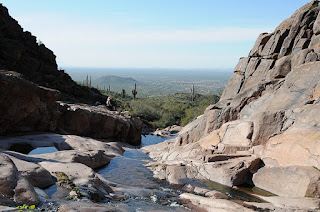Superstition Wilderness
Not too many years ago, getting to Hieroglyphic Canyon in the Superstition Wilderness Area required some effort. A long approach, unclear route and an ever-encroaching quagmire of private property and access restrictions precluded all but the most robust and determined hikers from visiting the canyon and its treasure trove of ancient Hohokam rock art. Recently, the Superstition Area Land Trust (S.A.L.T.) and Pinal County worked together to make Hieroglyhic Canyon more accessible. Through their efforts, a developed trailhead and parking area sprung up where once only limited roadside pullouts served as parking spots. There’s even a porta potty now. At first blush, this was a wonderful accomplishment. These improvements opened up the area to thousands who would otherwise miss the opportunity to learn from and enjoy this national treasure. However, among the trail’s smartly designed informational signage, there’s not a word about the irreplaceable historical significance of the rock art. Archeologists believe the petroglyphs range in age from 2,000 to 200 years old. Images of animals, plants, humans and mysterious geometric designs pecked into the rock veneer give a rare and precious glimpse into the life and culture of Arizona’s native inhabitants. The glyphs are scattered across a segment of the canyon where water runs over stone terraces nearly year-round. It’s a beautiful sight to behold—natural, open and entirely exposed to vandalism and damage from careless visitors. We visited this area early in the morning of February 21, 2009 and arrived at the petroglyph site around 8:30 a.m. By 9:30, the canyon had become overrun with visitors, many of whom proceeded to demonstrate an absolute disregard for historic preservation by climbing on (ON, not around) the artifacts. Young children were allowed to ply the ancient etchings with peanut butter encrusted fingers while cell phone wielding teens teetered atop an elegant set of animal drawings, chattering like baboons as the soles of their shoes chafed the delicate art. Granted, much of this behavior may be happening because people simply do not understand the rock art’s significance and fragility. In fact, while we were there, we conducted an informal query of the perpetrators and found that some of them had no idea the petroglyphs were “real”. Because of all the interspersed modern graffiti, one man assumed that all of the markings were the work of latter-day hoodlums. As the canyon swelled with droves of careless explorers, I struggled with a churning mix of anger, sadness and an urge to scream “get off the friggin petroglyphs!” Instead of making an ass out of myself, I wrote this diatribe—which makes me feel better, but does little to solve problem. You can help by educating your friends, families and co-workers about historical site preservation. Send them the link to this blog posting and the link to the Archeological Site Etiquette Guide shown below. Also, feel free to pester the following agencies at will.
LENGTH: 3 miles round trip
RATING: easy
ELEVATION: 2,050-' 2,620'
GETTING THERE:
From Phoenix, take US 60 east to Apache Junction. Between milesposts 202 and 203, turn left onto Kings Ranch Road and go 2.8 miles to Baseline Road. Turn right and follow Baseline 0.3 mile to Mohican, turn left, go 0.3 miles to Valley View. Turn left and follow Valley View (turns into Whitetail Road) to Cloudview Ave, turn right and continue 0.5 mile to the trailhead.
INFO: Tonto National Forest
http://www.fs.usda.gov/recarea/tonto/recreation/hiking/recarea/?recid=35483&actid=50
Archeological Site Etiquette Guide: http://azstateparks.com/SHPO/etiquette.html Superstition Area Land Trust (S.A.L.T.) http://www.azsalt.org/ Arizona Archeological Society http://www.azarchsoc.org/phoenixchapter.html







